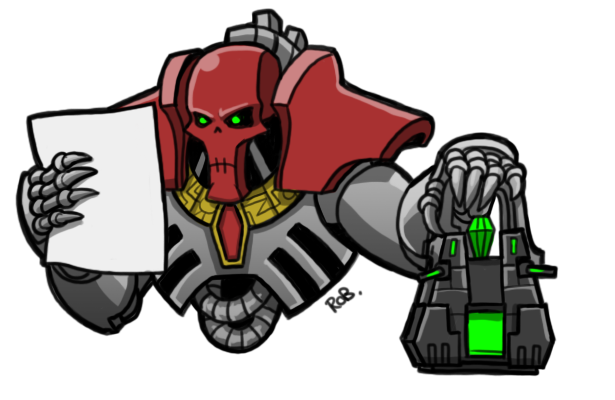The armies and factions of Warhammer 40,000 are all brutal and impressive in their own ways. As new books release, we dive into the lore presented in each, and how it shapes the fictional universe we love and make war in. In today’s review, Raf Cordero is diving into the lore presented in the new 9th edition Codex: Necrons and how it presents one of the game’s most frightening factions.
Immortal Warriors
Soulless glowing eyes. Implacable waves of soldiers. Gauss weapons that painfully disassemble you atom by atom. The Necron are rightfully feared across the galaxy. These un-living warriors march to battle in armor of living metal, no longer organic but not completely mechanical either. Thanks to reanimation protocols, Necrons often don’t stay dead for very long; soldiers of every species have to contend with the bodies of Necron warriors they’ve just blasted reassembling right in front of their eyes.
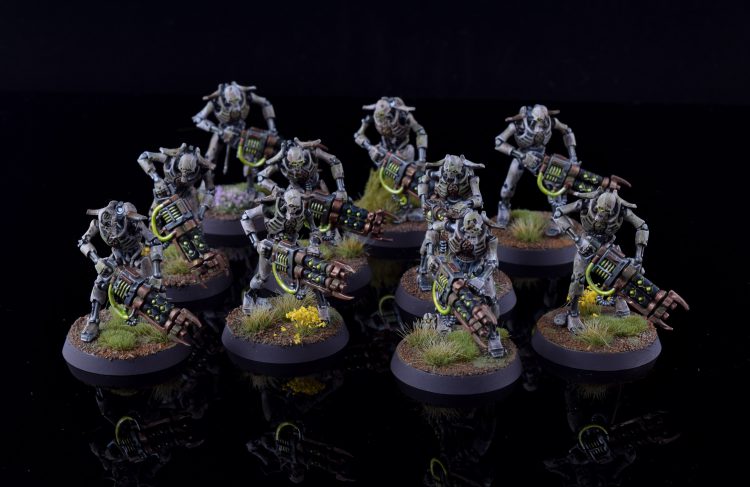
If armies of Necrons gathering in deep space isn’t enough, the various factions fighting for the galaxy also have to contend with the hidden threat of Necron tomb worlds. Necrons are ancient; they’re one of the oldest species fighting for galactic dominance. They have not, however, spent all this time living in the deep corners of the galaxy. Millennia ago, the Silent King Szarekh sealed his people in subterranean tomb-crypts spread throughout the galaxy. There the Necron slept for millions of years, kept alive through arcane technology and the care of crypt-thralls.
Now they’ve begun to awaken. Whether it’s a defensive response to another race discovering the tombs, a malfunction of the crypt, or a response to some unknowable signal, the tomb worlds are beginning to come to life—spelling nearly certain doom for any inhabitants that have moved onto the surface in the years since the Necron went to sleep. Caught unawares, the living denizens of these tomb worlds and quickly trampled under silver foot or disassembled by gauss weaponry as the immortal warriors begin their march anew.
The War in Heaven
The Necrons haven’t always been soulless mechanical monsters, however. There was a time when they were living organic creatures. In contrast to the immortal warriors they would become, the Necrontyr lived short brutish lives. They were factitious, quarrelsome, and prone to war. In an attempt to unite the Necrontyr, Szarekh launched a war on some immortal beings known as The Old Ones.
The resulting war was brutal and deadly for the Necrontyr. Thanks to the Old Ones’ mastery of the webway, the Necrontyr were constantly on their back foot. The were forced to turn to the C’tan in desperation. The C’tan were also Celestial Gods, though each with their own quirks. Imagine our own mythological gods like Zeus or Anubis only more sinister. It was the C’tan known to the Aeldari as Mephet’ran, known as The Deceiver to others, who brought promises to Szarekh. Ally with the C’tan and the C’tan would destroy the Old Ones.
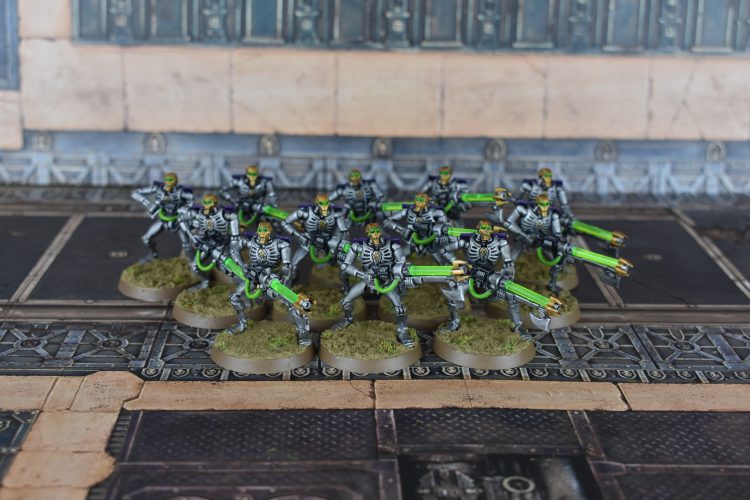
After deliberating, Szarekh agreed. The C’tan gave unto the Necrontyr the process of “biotransference”; it conferred the immortality the Necrontyr so desperately wanted at the low low cost of their souls. That were subsequently devoured by the C’tan. Whoops. Fortunately for Szarekh, this process also stripped most of the Necron (as they are now known) of their souls, personalities, and desires, so his rule wasn’t immediately challenged.
Bloated on souls and tired from eradicating an entire race, the C’tan suddenly presented a target for vengeance. Szarekh led the Necron against the very beings who had turned them into mechanical monsters. The C’tan were shattered, with pieces of their existence scattering across the galaxy. Some of these shards would eventually be captured and enslaved by the Necron. Others lay waiting to be discovered; it is believed that a shard of the Void Dragon lies on Mars.
After defeating the C’tan, there was one major threat left to the new Necron species: the Aeldari. Ancient servants of the Old Ones, the Aeldari were a force that the Necron could not face. Rather than dash his people on the cliffs of another unwinnable war, Szarekh commanded that his people enter their statis-crypts and sleep in their tomb worlds. Millenia later they would rise and retake the galaxy. The only one who would not sleep would be Szarekh himself. He destroyed the protocols granting him command of all the Necron and left the galaxy to see what he would find beyond the stars.
Rise of the Necron
If Szarekh had hoped that releasing the command protocols and interring his people in tomb cities would lead to them waking up rested and ready to bring about a new era of Necron dominance, he was half right. Those Necron that do emerge from their tomb worlds do tend to be ready to seek dominance only it isn’t quite the unified war he’d envisioned. The Warhammer 40,000 universe is generally pretty shitty unless you’ve missed the satire and see it as aspirational, but it was particularly shitty to our sleeping beauties. Asteroids, star-death, stellar radiation, and plain old code corruption has lead to some pretty significant issues.
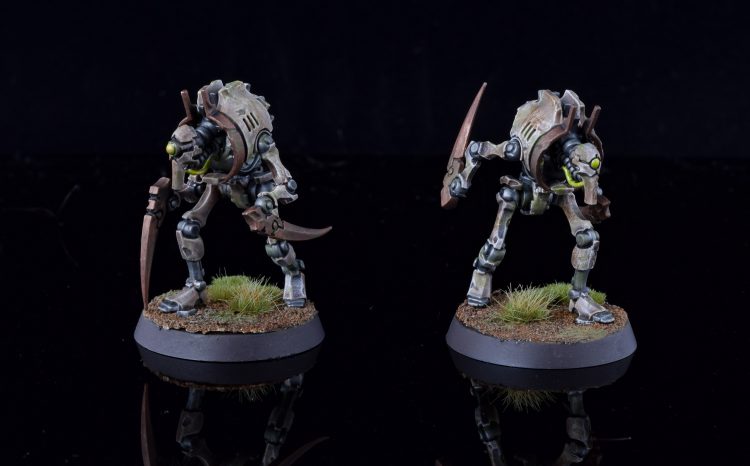
Entire tomb worlds have been lost to planetary destruction or invaders and the destruction of the command protocols led to other issues. Those Phaerons and Praetorians that have regained their independence are loath to give it up; they’ve organized into Dynasties and as as wont to attack each other as they other other species. When Szarekh destroyed the command protocols and gave the Necron free will, he also returned some bit of their personalities. Coupled with the decay and damage, the dynasties and their leaders have personalities and motivations that breathe some life into these soulless machines.
Dynasties and Power Players
Like every faction in Warhammer 40,000, you’re free to paint your models however you like and make up your own dynasties and heroes. However, the Codex includes a number of the more infamous Necron forces.
Sautekh Dynasty
The Sautekh, currently led by Imotekh the Stormlord, has one of the most impressive arrays of military might seen amongst the Necron. Their crownworld, Mandragora the Golden, is nigh impenetrable. Bastions upon bastions, legions behind legions, the Stormlord has built, recruited, or simply taken over legion after legion. Imotekh did not awaken to a seat of power, however. He was woken up by one of the many Overlords vying for Mandragora’s throne. Digusted by what he saw, Imotekh used his military acumen to simply destroy the warring pretenders and assume the mantle of power himself.
Imotekh awoke from the Great Sleep possessed with logic and insight far beyond the understanding of mortal beings. To his enemies, the Stormlord’s abilities seem magical but it is raw insight fueled by the Necron’s characteristic arrogance that leads Imotekh to victory. His only vice is a deep hatred for anyone or anything that might rise as a rival. When faced with such a threat, Imotekh is known to challenge them to single combat. While undefeated, Imotekh rarely kills his opponent preferring instead to take a hand as trophy. The list of grudge-holding enemies grows ever longer.
Nihilakh Dynasty
Remember the Old Ones that the Necrons traded their everloving souls for? They weren’t quite wiped out completely. The Nihilakh got ahold of the severed head of one of the last remaining Old Ones and now use it to peep through the curtains of time. This allows them to get ahead of the enemy and attack precisely where they need to be, when they need to be there.
Originally of the Nihilakh Dynasty, Trayzn the Infinite is more concerned with collecting artifacts and knowledge than he is fighting for any particular emerging power. Trazyn is known for the holographic galleries he assembles after capturing grand historical moments in light. More concerned with drama than accuracy, he his happy to replace old figures in his diorams with anything that makes them more exciting, like a manic Armies on Parade board. He also wields the Empathic Obliterator, a weapon that slays its target and anyone nearby “of a like mind and purpose”, which is cool as shit.
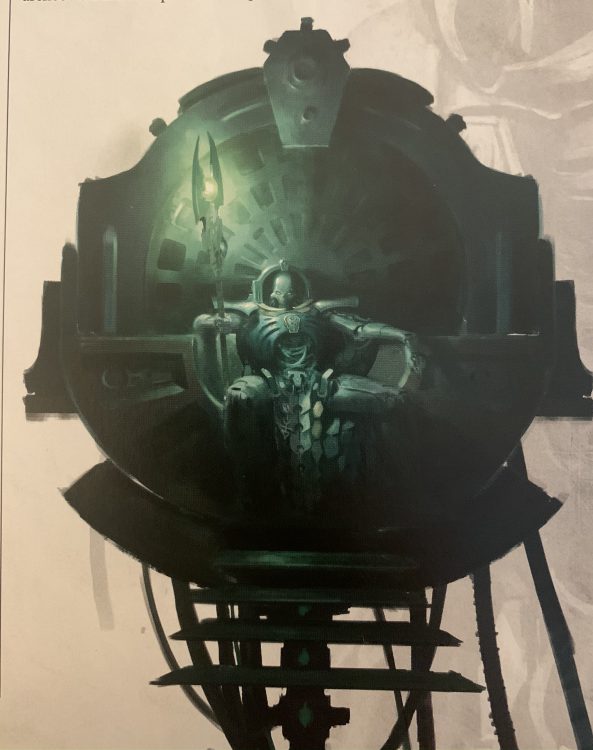
Szarekhan Dynasty
The rising Necron power in the modern timeline is the Szarkhan Dynasty though it was not always this way. This Dynasty was slow to wake up, and in its weakened state was often seen as an opportunistic target. They persevered, however, confident that the prophesy would be fulfilled and that Szarekh the Silent King would return.
And return he did.
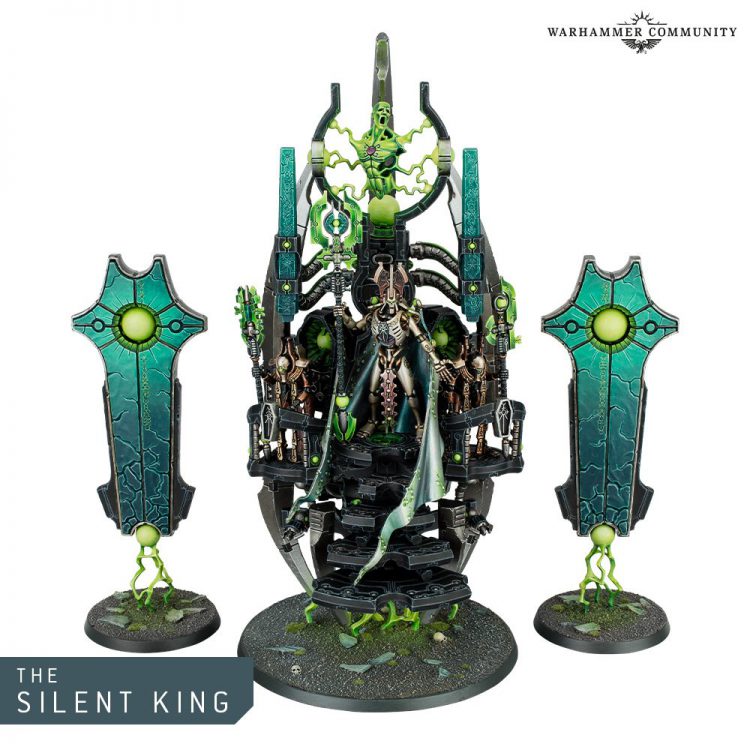
Szarkh the Silent King has returned to the galaxy and set his millennia-spanning plans into motion. While not confirmed, it is believed that the reason he has returned is that he encountered the Tyranid Hive-Mind and is in a race to safe his species. Armed with knowledge of how to deploy blackstone in warp-dampening configurations, Szarekh has begun creating null-zones in space.
You can read more about these in our lore review of Pariah, but the basics are simple: skewering plents with large blackstone pylons and attuning them in just the right way cuts entire systems off from the Warp. Ships can’t travel, psykers can’t cast spells, demons are weakened, and humans lose their will to fight and live. All of this, however, may simply be a happy side-effects to the real purpose. If its true that Tyranids are attracted to the Astronomicon, and Szarekh can completely ring the galaxy in null-zones, perhaps he can save his people and achieve galactic domination all at once.
Wrap-up
The Codex goes into more detail on Necron hierarchy and force organization, and details a few more dynasties and characters for those interested in joining the metallic ranks. As opposed to the Space Marine Codex, which dedicates quite a bit of space to Chapter organization, heraldry, and “technical” details, the Necron codex builds a haunting and mysterious environment. It even includes a 2 page spread of an Aeldari story of the War in Heaven. This is where the C’Tan get more of a mention, as it describes the Necrons turning on their star god masters/betrayers.
While the Necrontyr were certainly not “good”, their fall is a tragic one. Their rise? Well, that’s less tragic. The null zones that are ringed around the galaxy “like a noose” are not good for the Imperium or any other race that dabbles with warp or magic. For anyone picking up this army with the release of the new starter set, this book should get you pretty excited to paint those skeletons you just picked up.
Rob’s Note: Overall the Codex is great and the reduced fluff works – having a full page dedicated to each unit didn’t seem sustainable. The big thing missing here for me is anything on the Void Dragon, however. I’ve been waiting something like 20 years for a Void Dragon and the book barely mentions what was supposedly the mightiest of all the C’Tan. C’mon GW!
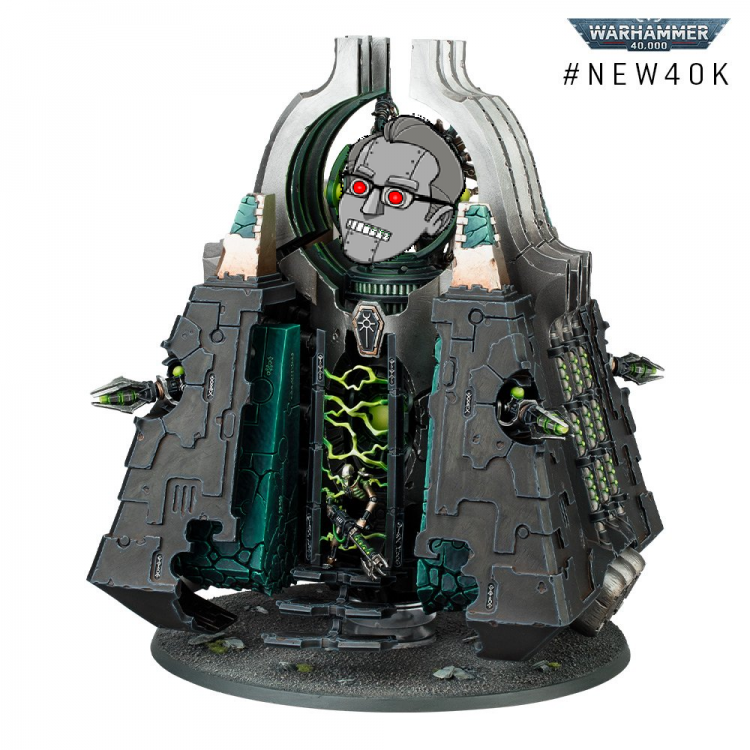
Have any questions or feedback? Drop us a note at contact@goonhammer.com.
